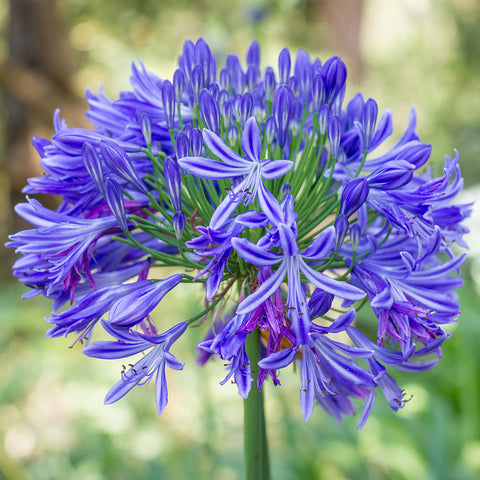Releasing the Secret to Successful Agapanthus Growing: Tips and Tricks for a Flourishing Yard
In the realm of gardening, growing agapanthus successfully needs a calculated approach that includes numerous aspects of plant treatment. By comprehending the nuances of agapanthus growing, one can develop an atmosphere where these plants flourish and grow abundantly.
Planting Agapanthus: Best Practices
When planting Agapanthus, proper dirt preparation is important for ensuring effective growth and development of these attractive flowers. Agapanthus, commonly referred to as Lily of the Nile or African lily, flourishes in well-draining soil with a slightly acidic to neutral pH level - Agapanthus. Prior to growing, it is important to modify hefty clay soils with raw material such as garden compost or peat moss to improve drain and supply vital nutrients for the plants
To plant Agapanthus, select a location that obtains full sunlight to partial shade, as this will certainly promote healthy and balanced growth and abundant blooming. Dig an opening twice the size of the plant's origin ball and put the Agapanthus at the exact same deepness it was formerly expanding. Delicately backfill the hole with soil, pressing down firmly to get rid of any type of air pockets around the origins.
Water the recently grown Agapanthus extensively and proceed to maintain the dirt equally damp, specifically during the plant's active expanding season. Agapanthus. Applying a well balanced plant food once a month can additionally sustain the plant's growth and blooming. By adhering to these ideal practices for growing Agapanthus, you can create a spectacular display of these exciting flowers in your yard
Suitable Soil Issues for Agapanthus
For ideal growth and blooming success of Agapanthus plants, guaranteeing the dirt conditions are optimal is critical. Agapanthus likes soil that is abundant in nutrients, so including a well balanced fertilizer during the expanding season can promote healthy development and lively blossoms.

Watering and Feeding Tips
To ensure healthy development and lively blooms, appropriate watering and fertilizing strategies are necessary for effective Agapanthus cultivation. Agapanthus plants benefit from regular watering, particularly throughout the growing season.
When it comes to fertilizing Agapanthus, a balanced fertilizer with equal parts nitrogen, phosphorus, and potassium can be applied in the spring to advertise healthy growth and flowering. Slow-release plant foods are optimal for providing nutrients slowly over an extensive duration. Stay clear of over-fertilizing, as this can lead to extreme foliage growth at the expense of flowers.
Additionally, incorporating raw material like compost into the dirt can improve nutrient levels and enhance soil structure, assisting in the overall wellness of the Agapanthus plants. By following these watering and feeding tips, gardeners can guarantee their Agapanthus plants thrive and generate magnificent screens of blossoms.
Trimming and Deadheading Techniques
Correct trimming and deadheading methods play a vital duty in maintaining the health and looks of Agapanthus plants, matching the essential methods of watering and fertilizing for effective farming. Trimming Agapanthus includes getting rid of spent blossom heads, yellowing or dead leaves, and total shaping of the plant to advertise far better development. Deadheading, the procedure of getting rid of faded blossoms, not just boosts the plant's appearance however additionally encourages more growing.
When deadheading Agapanthus, it is recommended to trim off the blossom stem at the base using sharp, tidy shears. This procedure redirects the plant's power from seed production back right into origin and vegetation growth, promoting a much healthier and a lot more robust plant. Regular deadheading can extend the blooming period of Agapanthus and stop self-seeding, which click to investigate can bring about congestion.
In terms of trimming, Agapanthus typically take advantage of a light trim after blossoming to tidy up the plant and urge fresh development. Cutting down the invested flower stems and getting rid of any type of dead or damaged foliage assists maintain the plant's vigor and total appearance. However, it is vital to stay clear of cutting into the crown of the plant, as this can deteriorate its wellness.

Protecting Agapanthus From Pests and Diseases
Implementing reliable bug and disease monitoring techniques is critical to protecting the health and vitality Full Report of Agapanthus plants in growing. One typical parasite that impacts Agapanthus is the Agapanthus borer, a caterpillar that passages right into the plant, creating damages to the blossoms and fallen leaves.
In enhancement to bugs, Agapanthus are susceptible to diseases such as origin rot and fungal leaf spots. By staying vigilant and dealing with pest and condition issues immediately, gardeners can aid their Agapanthus flourish and prosper.
:strip_icc()/purple-agapanthus-4637b426-ba6babc24ea34dce9361ec746f6ebc63.jpg)
Final Thought
In verdict, effective farming of agapanthus needs appropriate growing methods, optimal dirt conditions, sufficient watering and feeding, regular trimming and deadheading, and security from pests and diseases. By adhering to these methods and tips, garden enthusiasts can ensure a growing yard full published here of gorgeous agapanthus flowers. Agapanthus. Remember to keep consistent treatment and attention to detail to promote the health and wellness and long life of these magnificent plants
When planting Agapanthus, correct dirt prep work is necessary for ensuring effective development and development of these attractive flowers.Water the recently grown Agapanthus extensively and continue to maintain the dirt equally wet, specifically throughout the plant's energetic expanding season.For optimal growth and blooming success of Agapanthus plants, ensuring the dirt problems are suitable is essential. When planting or transplanting Agapanthus, make certain the dirt is well-prepared to offer the needed structure for the plants to establish themselves successfully. One usual insect that impacts Agapanthus is the Agapanthus borer, a caterpillar that tunnels right into the plant, creating damage to the fallen leaves and blossoms.